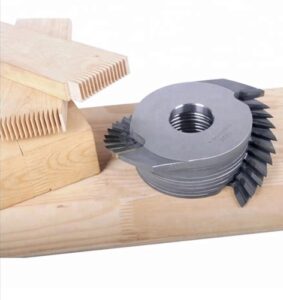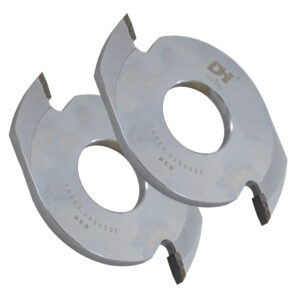Finger joints are one of the strongest types of joints and are used in a variety of woodworking projects. This joint is formed by interlocking the end of one piece of wood with the end of another, forming a strong connection that can withstand a variety of forces. This joint is widely used and can be used to connect two pieces of wood of different thicknesses and lengths.
Finger joint knives are available in two forms: full-length finger joint knives and single-length finger joint knives. Single-length finger joint knives include single-tenon knives and edge knives. Single-length finger joint knives are usually used as a set.
Finger joint knives are divided into integral materials and split materials from the material. Full-length finger joint knives are made of high-speed steel or T8 steel.
Split-material finger joint knives are composed of two materials: the knife body and the knife head. There are two types of materials: inlaid and welded. The knife head material is high-speed steel and carbide.
So, how should we choose the best finger joint knife? There will be four key points to consider below for your reference. I hope it will be helpful for your choice.
Material of Finger Joints
Regarding the choice of finger joint knife material, we need to know that manganese material is not easy to deform and has good strength after heat treatment. Carbide has high hardness and good wear resistance, but it is not easy to process.
Parameters of Finger Joints
The most important thing is the inner hole and outer diameter of the finger jointing knife. The inner hole and outer diameter of the finger jointing knife are determined according to the equipment you use. Different equipment has different positions and gaps between the knife shaft and the knife. Therefore, you need to consult your equipment supplier to choose the correct inner hole and outer diameter.
The second is the number of teeth. The number of teeth of the finger jointing knife is generally two teeth or four teeth, which is determined by the speed of the equipment. The number of teeth is selected according to the speed of the equipment. Fast equipment uses a tool with a small number of teeth, and slow equipment uses a tool with a large number of teeth. However, more teeth can improve the finish of the cutting surface. Generally, a multi-tooth finger jointing knife is selected, among which four teeth are the most popular.
Another thing to consider is the angle of the finger jointing knife. Its angles mainly include the front angle, the back angle, and the bevel angle. The angle of the finger jointing knife is determined by the material of the processed wood, the depth of the finger jointing, and the speed of the equipment. If you do not have clear requirements for these angles, you can inform the material of the processed wood, the depth of the finger jointing, and the speed of your equipment.
The depth requirements of finger joints vary. When other conditions are the same, the bevel angle is different, the equipment speed is different, the front angle and back angle of the tool are different, the front angle of the tool is large when the speed is slow, and the front angle of the tool is small when the speed is fast.
Processing Materials
Due to the wide variety of wood materials, such as paulownia, pine, birch, oak, etc., their softness and hardness vary greatly, so when choosing a finger joint knife, you also need to consider the material to be processed in order to find the tool with the best processing effect.
Finger Joints Accuracy
The accuracy of the finger joint knife includes the flatness, parallelism, verticality, end jump, etc. of the direct material. The accuracy of the finger joint knife is the embodiment of the inherent quality of the finger joint knife. The accuracy of the finger joint knife is determined according to the production capacity and production conditions of the manufacturer, so it is particularly important to choose a high-quality manufacturer with rich production experience.
Finger joints are generally stronger than butt joints and can be used to join pieces of wood that are not perfectly aligned, which makes them ideal for furniture and cabinet making.
At the same time, finger joints are also used to join pieces of wood that are too short to be joined with full-length joints. This is particularly useful when making furniture with intricate designs, as it allows the carpenter to create the desired shape without using longer pieces of wood. This joint is also often used to join pieces of wood that are too thin to be joined with full-length joints. If you learn how to choose the best finger jointing knife, I believe this tool will definitely play a very important role in your woodworking projects.



